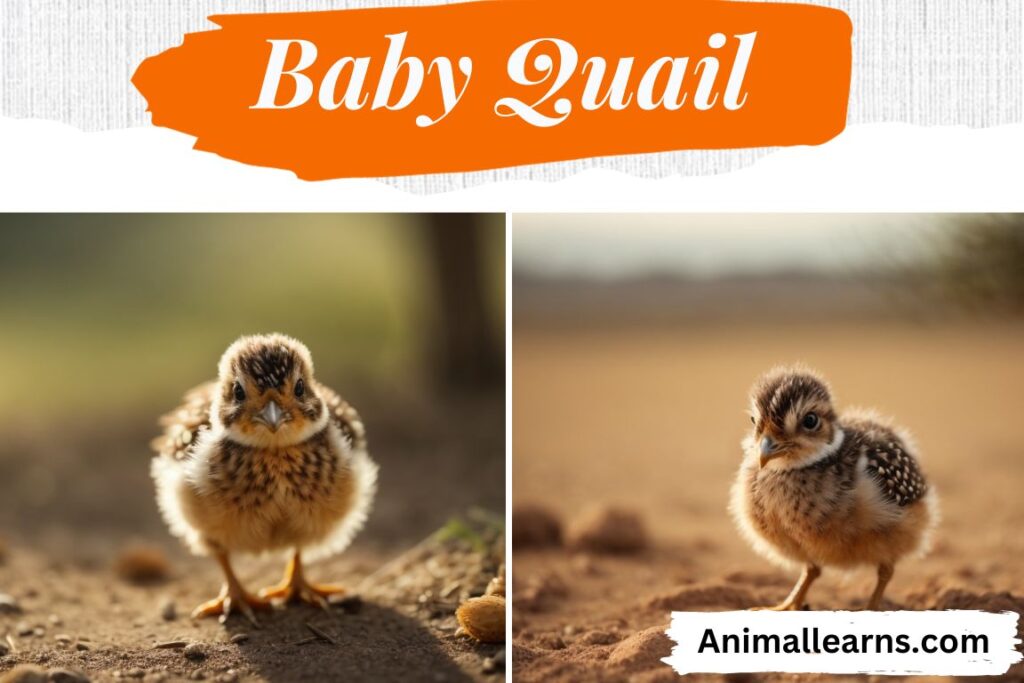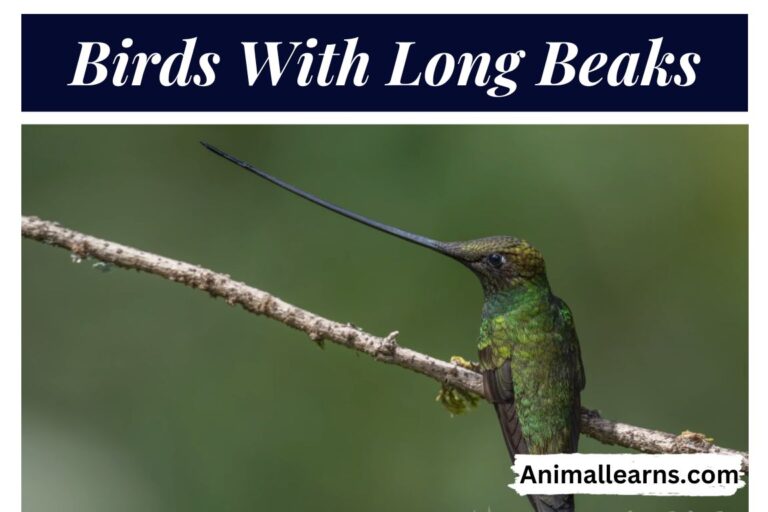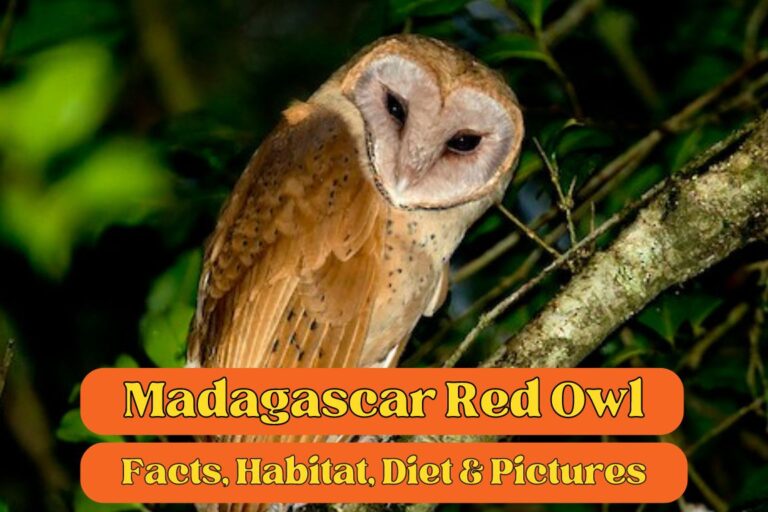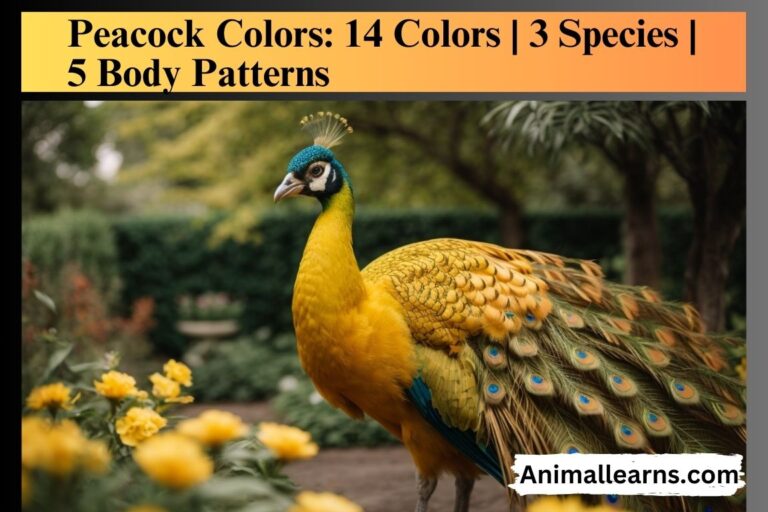Baby Quail: What to Feed & How to Raise Them

- Scientific Name: Coturnix coturnix
- Appearance: Baby quail are small, plump birds with short necks and rounded bodies. They have stubby legs and wings that are not yet fully developed. Their down feathers are soft and fluffy, and they have a small, pointed beak.
- Size: Baby quail is about the size of a golf ball at hatching. They grow to be about 6-7 inches (15-18 cm) long as adults.
- Weight: Baby chick quail weighs about 0.4 ounces (11 grams) at hatching. They can reach a weight of up to 13 ounces (370 grams) as adults.
- Color: Baby quail are born with down feathers that are typically yellow, brown, or black. Their adult plumage can vary depending on the subspecies, but it is typically a combination of brown, black, and white.
- Lifespan: They can live for up to 10 years in captivity.
- Location: They can be found all over the world, but they are most common in Europe, Asia, and Africa.
These are amazing to see. With their large, inquisitive eyes and fluffy, silky feathers, they are incredibly little and fragile. In addition, they have highly busy lives, always investigating and picking up new skills related to their environment.
When quail hatchlings first emerge, they are defenseless. They are unable to stand up on their own, hear, or see. Their mother is the one who takes care of feeding and heating them. But in a few days, they start to expand and change swiftly.
They can feed and drink on their own by the time they are 2 weeks old, and they are beginning to investigate their environment more freely. Baby quail, baby crow, and baby geese are amazing and innocent babies. Which is a masterpiece of natural scenery.
What Does a Baby Quail Look Like?
Contents
- 1 What Does a Baby Quail Look Like?
- 2 What Do Baby-Quails Eat?
- 3 Exploring the Nesting Habits of Baby Quails
- 4 How Long Do Baby Quail Stay In Nest?
- 5 Unveiling the Baby Quail Survival Rate
- 6 Decoding the Ideal Baby Quail Size
- 7 How Many Babies Do Quails Have?
- 8 Mastering the Art of Baby Quail Hatching
- 9 Are Quail Easy To Raise?
- 10 Why Quails Are Easy to Raise
- 11 Fast Starters in Egg Production
- 12 How to Save a Baby Quail from Dying
- 13 How To Build A Quail Cage
- 14 Baby Quail Laying on the Side
- 15 Baby Quail Sleeping On Its Side
- 16 Baby Quail as a Pet
- 17 Maintaining the Perfect Baby Quail Temperature
- 18 Baby Quail Care Essentials for Beginners
- 19 Baby Quail Inn Sedona United States Of America
- 20 How to Tell Baby Quails Apart?
- 21 FAQs

Because they are precocial, they can follow their parents soon after hatching and are rather mobile. Their thick feathers, which serve as both insulation and disguise, cover them. Their complex patterns and usual colors of browns, tans, and yellows enable them to blend in with their environment.
Large, curious eyes and sharp beaks designed for gathering tiny seeds and insects characterize baby-quails. Because of their long, thin legs, they can move swiftly and through thick foliage. Their downy feathers eventually molt into adult plumage as they become older, and learn to fly.
What Do Baby-Quails Eat?
The main food source for these quails, among their varied diet, is insects. They can eat a wide range of invertebrates, such as ants, beetles, caterpillars, spiders, and crickets, thanks to their tiny beaks and digestive systems. For developing chicks, these insects offer a plentiful supply of protein and other minerals.
They eat tiny seeds, fragile fruits, and tender greens in addition to insects. These enhance their general growth and well-being by offering more fiber and minerals. Quail gradually adapts to a more adult diet as they become older, which consists primarily of seeds and grains.
Exploring the Nesting Habits of Baby Quails
Building nests is an essential part of the quail mating cycle because it gives their growing young a secure sanctuary. Chicks or poults are other names for baby-quail.
They are altricial, which means that when they hatch, they are defenseless and need care from their parents. Building and incubating the nest is mostly the job of the female quail.
Usually, nest locations are hidden in thick undergrowth or behind protective coverings like overhanging branches or large rocks. The nest is a ground-level hole filled with soft materials such as feathers, leaves, and grasses. This gives the weaker chicks warmth and insulation.
Eggs from quail can take anywhere from 21 to 23 days to incubate. The mother quail watches intently during this period, sitting on the nest to keep the eggs safe from predators and to maintain a constant temperature.
The mother keeps the chicks warm and cares for them once they hatch, showing them where to find food and water.
How Long Do Baby Quail Stay In Nest?

After hatching, baby chicks quail, sometimes referred to as chicks or poults, usually spend two to four days in their nest. During this brief time, the chicks can begin to learn how to seek food from their parents and develop their downy feathers.
They will leave the nest and accompany their parents as they look for food until they are strong enough to live on their own.
Here’s a more thorough explanation of the normal nesting season for young quail:
Days 1-2: The chicks stay in the nest and cuddle up to one other to stay warm. They will be cared for and shielded by their mother quail.
Days 3–4: The chicks begin to investigate their environment and make brief trips outside the nest. They will continue to spend the night in the nest.
Day 5–6: The chicks can now follow their parents around and are completely mobile. They will begin to roost at night in protected places instead of sleeping in the nest.
Unveiling the Baby Quail Survival Rate
Estimates of the survival rate of newborn quails range from 5 to 30 percent, which is rather low. Many causes, including malnourishment, illness, exposure, and predation, are blamed for this high death rate. Young quails are seriously threatened by predators including foxes, snakes, and preying birds.
Their ability to survive can also be harmed by exposure to adverse weather, such as extremely high or low temperatures or prolonged periods of rain. Diseases and dietary deficiencies can also weaken chicks and increase their risk of dying.
Decoding the Ideal Baby Quail Size
A young quail’s optimal size varies based on its species and age. Nonetheless, healthy newborn quails weigh between 0.5 and 1 ounce (14–28 grams) at hatching, which is rather modest.
They acquire about 0.1–0.2 ounces (3-6 grams) every day, growing quickly. They normally weigh between two and three ounces (57 and 85 grams) at three weeks of age.
Quails’ weight can be used to gauge their general growth and health. A steady increase in weight shows that the chicks are growing and getting enough food.
On the other hand, if a chick is not gaining weight or is losing weight, there can be underlying medical conditions or nutritional deficits at play.
How Many Babies Do Quails Have?

Depending on the species, quails can have one or many young. While some species of quail produce clutches of as many as 20 eggs, others only lay as few as 6. Most quail species have an average clutch size of 12–14 eggs.
Quail eggs normally take between 21 and 23 days to incubate. The mother quail will tend to the eggs once they hatch, giving them food, warmth, and shelter. Precocial chicks have downy feathers from birth and can move and feed themselves very quickly after hatching.
Mastering the Art of Baby Quail Hatching
A lot of things need to be carefully considered for baby quail hatching to be successful, including humidity conditions, clean nests, and appropriate incubation.
The act of keeping the environment containing the eggs consistently damp and at a temperature that supports embryonic development is known as incubation.
Quail eggs should be incubated at a temperature of around 99.5 degrees Fahrenheit (37.5 degrees Celsius). It’s important to keep humidity levels between 50 and 60 percent.
Keeping the nest clean is essential to stopping the spread of infections and illnesses that might affect the chicks that are hatching. Regular provision of clean, fresh bedding and maintenance of the nesting place are important.
Are Quail Easy To Raise?

Yes, backyard poultry aficionados often choose quail since they are quite simple to grow. Compared to chickens or ducks, they are hardier, smaller birds that need less room and feed.
They are excellent neighbors for both people and other pets because they are also generally calm and obedient.
Quail may lay up to 300 eggs a year, making them excellent egg producers as well. Their little yet tasty eggs are an excellent source of vitamins and protein. In many regions of the world, quail is a popular game bird and may also be bred for their meat.
There are several things you should be aware of if you plan to raise quail.
- Quail are skilled flyers, so a tall and secure cage is essential to prevent them from escaping.
- Quail are omnivores and require a balanced diet of both plant and animal matter.
- Regular cleaning of the enclosure is necessary to prevent disease and maintain hygiene.
- Daily provision of fresh food and water is essential for their well-being.
Why Quails Are Easy to Raise
Backyard enthusiasts sometimes choose quails over other birds because they are reasonably simple to nurture. They are easier to handle because of their modest stature, placid demeanor, and simple nutritional requirements.
A somewhat resilient bird, quails may also thrive under a range of conditions. If they have access to a shelter, enough room, and a healthy feed, they may be grown both indoors and outdoors.
Fast Starters in Egg Production
The ability of quails to develop maturity and produce eggs as early as 6–8 weeks of age is well documented. For those who are interested in homegrown eggs, this makes them an easy and satisfying decision.
Qualils lay a lot of eggs—between 100 and 300 on average each year. Their little eggs have a high yolk content and are tasty.
How to Save a Baby Quail from Dying
Quilling is a sensitive species that can die from a number of causes, such as disease, trauma, and exposure. Early identification of distress indicators can improve a young quail’s chances of survival.
It’s critical to respond quickly if you see a young quail acting weak, listless, or exhibiting strange behavior. Look for indications of trauma, such as blood or shattered bones. See a veterinarian or seasoned quail breeder for advice if you suspect a disease.
A newborn quail’s chances of survival can be greatly increased by providing warmth, supportive care, and a suitable diet. Make sure fresh water is available, provide a balanced meal, and maintain a constant temperature and humidity level.
A quail cage is an excellent means of providing your pet with safety and comfort. This is a detailed instruction manual for constructing a quail cage:
How To Build A Quail Cage
Materials:
Mesh wire, wooden framework, latches and hinges, Watering and feeding the cups
Tools:
Drill steps for screwdriver, pliers, and wire cutters:
Steps:
- To fit, cut the wire mesh. The quantity of quail you own will determine the cage’s size. Giving each quail at least one cubic foot of space is a decent general rule of thumb.
- Secure the wire mesh to the frame made of wood. To keep the mesh in place, use wire ties or staples.
- Cut a piece of the wire mesh to create a door. Use hinges to fasten the door to the frame.
- Put locks on the watering and feeding cups, as well as the entrance.
- The cage should be placed away from drafts and bright sunshine.
- Fill the cage with bedding. Soft bedding, such as shavings of wood or straw, is preferred by quail.
- Give your quail some food and drink. Fresh water and quail meal constitute the diet of quail.
- Regularly clean the cage. Because quail are filthy animals, you will need to routinely clean their cage.
Baby Quail Laying on the Side
Young quails frequently sleep on their backs or sides. This conduct is typical and shouldn’t raise any red flags. They also frequently sleep with their legs extended in the air. This is a result of their inability to properly control their underdeveloped legs.
Baby Quail Sleeping On Its Side
Make sure your young quail is not chilly before assuming anything about its sideways orientation. It is necessary to maintain a temperature of 95 to 100 degrees Fahrenheit for baby-quails. Your young quail may get drowsy and lie on its side to retain body heat if the temperature drops too much.
Additionally, you want to confirm that your young quail is receiving enough amount of food and water. Make sure that they always have access to fresh food and water since they need to eat and drink often.
Baby Quail as a Pet

Small, ground-dwelling birds and quails are indigenous to many regions of the world. Because they are not as noisy as some other birds and are comparatively easy to care for, they are popular pets. In addition to being gregarious, quails love being among people.
Maintaining the Perfect Baby Quail Temperature
For survival, these babies require a warm atmosphere. For newborn quails, the optimal temperature range is 95 to 100 degrees Fahrenheit.
Your newborn quails may become sluggish and may not feed or drink appropriately if the temperature is too low. Your newborn quails run the risk of overheating and being dehydrated if the temperature is too high.
You may do a few things to keep your newborn quails at the ideal temperature. To provide them with a warm source of heat, you can use a brooder or a heat lamp. To prevent them from being overheated, you should also make sure that their cage has adequate ventilation.
Baby Quail Care Essentials for Beginners

There are a few things you should know if you’re new to rearing newborn quails in order to keep them happy and healthy.
Housing: Give your newborn quails a tidy, roomy cage that is draft-free, well-ventilated, and clean. Since quails are skilled escape artists, the cage should also be impenetrable.
Bedding: Soft bedding is necessary for these babies to curl up in and stay warm. A range of materials are available for usage, including wood shavings, pine shavings, and shredded paper.
Temperature: In order to survive, they require a warm atmosphere. For newborn quails, the optimal temperature range is 95 to 100 degrees Fahrenheit. To provide them with a warm source of heat, you can use a brooder or a heat lamp.
Food and Water: A well-rounded diet consisting of a range of seeds, insects, and vegetables is necessary for babies. Your neighborhood pet store is a good place to get quail starting feed. Ensure that your newborn quails have access to clean, fresh water at all times.
Cleaning: To stop the transmission of illness, keep the enclosure housing your newborn quails clean. Every day, change the bedding and give the cage a quick spot clean.
Handling: To acclimate your infant quails to human contact, handle them regularly and carefully. They will become easier to handle and more subdued as a result.
Baby Quail Inn Sedona United States Of America
In Sedona, Arizona, there is a small motel called Baby Quail Inn that is run by a family. It is a well-liked location for both visitors and residents, and it is renowned for its reasonable prices, spotless accommodations, and welcoming personnel.
The hotel is conveniently close to a number of Sedona’s most well-known sites, including Red Rock State Park, Slide Rock, and the Chapel of the Holy Cross. It is also within walking distance of shops, restaurants, and grocery stores.
How to Tell Baby Quails Apart?
Understanding the appearance of a baby’s quail is the first step in their care journey. Knowing what a baby’s quail looks like is crucial for identifying any potential health issues. Differentiating between baby quail can be challenging, but knowing how to tell them apart is essential for providing tailored care.
When exploring what they eat, it’s important to consider the diverse quail breeds, such as Coturnix, Bobwhite, Button, and Japanese quail. As these quail breeds have unique characteristics, tailoring their diet and care is vital.
Additionally, raising adult quail involves creating a suitable environment, including knowing how to build a quail cage. Beyond the basics, exploring quail recipes like the grilled quail recipe adds an enjoyable dimension to raising these prolific egg layers.
FAQs
How do I save a baby quail from dying?
Ensure proper warmth, provide a balanced diet, and address any health concerns promptly. If needed, consult a veterinarian familiar with avian care.
What should I feed my baby quail?
Feed them a high-protein starter feed designed for game birds or quail. You can also offer finely chopped greens, insects, and small seeds.
How many babies do quail usually have at a time?
Quails are prolific breeders, and a typical clutch can range from 10 to 15 eggs. Hatching success depends on various factors.
How long should I keep babies quail in the brooder before they go outside?
Keep them in the brooder for about 4-6 weeks, ensuring they are fully feathered and can regulate their body temperature before transitioning outdoors.
What are some common quail breeds for raising?
Common quail breeds include Coturnix quail, Bobwhite quail, Button quail, and Japanese quail. Each has unique characteristics and care requirements.













